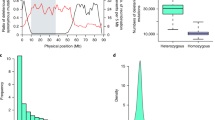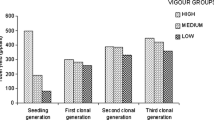Abstract
It is often assumed that the inbreeding status of progenies influences artificial selection. A study of the influence of the inbreeding coefficient of potato genotypes on the selection intensity in a potato cultivar development program was conducted. The inbreeding coefficient for the genotypes of 105 crosses investigated ranged from 0 to 0.11 and averaged 0.022. No significant relationship was found between the inbreeding coefficient and the proportion of genotypes saved at the single-hill, four-hill, ten-hill and hundred-hill stage of selection. The inbreeding coefficient was of little use in predictinga priori the selection pattern of a cross in a multitrait type of breeding program.
Compendio
Se asume con frecuencia que la condición de endocría de las progenies influencia la selección artificial. Se condujo un estudio de la influencia del coeficiente de endocría de genotipos de papa sobre la intensidad de selección en un programa de desarrollo de cultivares de papa. El coeficiente de endocría para los genotipos de 105 cruzamientos investigados varió de 0 a 0,11 y promedió 0,022. No se encontró una relación significativa entre el coeficiente de endocrío y la produción de genotipos retenidos durante las etapas de selección con una, cuatro, diez y cien matas. El coeficiente de endocría fue de escaso valor para predicira priori el modelo de selección de unb cruzamiento en un programa de mejoramiento del tipo de características múñtiples.
Similar content being viewed by others
Literature Cited
Busbice, T.H. and C.P. Wilsie. 1966. Inbreeding depression and heterosis in autotetraploids with application toMedicago sativa L. Euphytica 15:52–67.
Gallais, A. 1977. An experimental check of quantitative genetics on an autotetraploid plant,Medicago sativa L., with special reference to the identity by descent relationship.In: E. Pollack, O. Kempthorne and T.B. Bailey, Jr. Proc Inter Conf Quant Genet, Iowa State University Press, Ames. pp. 519–540.
Gallais, A. 1984. An analysis of heterosis vs. inbreeding effects with an autotetraploid cross-fertilized plant:Medicago sativa L. Genetics 106:123–137.
Glendinning, D.R. 1979. The potato gene-pool and benefits deriving from its supplemenation.In: A.C. Zeven & A.M. van Harten, Proc Conf Broad Genet Base Crops (1978). Pudoc, Wageningen. pp. 187–194.
Glendinning, D.R. 1987. Gene pool of modern potato varieties.In: G.J. Jellis and D.E. Richardson. The production of new potato varieties: technological advances. Cambridge University Press, Cambridge. pp. 28–30.
Lefort-Buson, M. 1985. Distance génétique et hétérosis. 3. Utilisation des coefficients de consanguinité et de parenté.In: M. Lefort-Buson and D. de Vienne. Les distances génétiques — Estimations et applications. I.N.R.A. Paris. pp. 131–141.
Lefort-Buson, M., Y. Dattée, B. Guillot-Lemoine. 1986. Heterosis and genetic distance in rapeseed (Brassica napus L.): use of kinship coefficient. Genome 29:11–18.
Malécot, G. 1948. Les mathématiques de l’hérédité. Masson et Cie. Paris. 63 p.
Mendoza, H.A. and F.L. Haynes. 1974. Genetic relationship among potato cultivars grown in the United States. Hortscience 9:328–330.
Michaud, R. and T.H. Busbice. 1977. Selection for seed set in noninbred and partly inbred populations of alfalfa. Can J Plant Sci 57:873–881.
Pfeffer Ch., K.-H. Möller, M. Scholz and H.-G. Zschüttig. 1988. Die Zuverlässigkeit der visuellen Selektion in der ersten Klongeneration von Kartoffeln. Potato Research 31:17–23.
SAS Institute Inc. 1985. SAS user’s guide: statistics, Version 5 Edition. Cary, NC. SAS Institute Inc. 956 p.
Sidhu, A.S. and M.L. Pandita. 1980. Genetic divergence for yield and its components in potato (Solanum tuberosum L.). Genet Agr 34:235–244.
Tai, G.C.C. and D.A. Young. 1984. Early generation selection for important agronomic characteristics in a potato breeding population. Am Potato J 61:419–434.
Tai, G.C.C., P.Y. Jui and D.A. Young. 1986. Evaluation of parents based on long-term selection records. Z. Pflanzenzüchtg. 96:39–46.
Wright, S. 1922. Coefficients of inbreeding and relationship. Amer Nat 56:330–338.
Wright, S. 1951. The genetical structure of populations. Eugenics 15:323–354.
Yoshida, T. 1986. Inbreeding coefficient and yield in sweet potato (Ipomoea batatas (L.) LAM.) Japan J Breed 36:409–415.
Author information
Authors and Affiliations
Rights and permissions
About this article
Cite this article
Loiselle, F., Tai, G.C.C., Christie, B.R. et al. Relationship between inbreeding coefficient and clonal selection in a potato cultivar development program. American Potato Journal 66, 747–753 (1989). https://doi.org/10.1007/BF02896831
Accepted:
Issue Date:
DOI: https://doi.org/10.1007/BF02896831




